外研版(2019)选择性必修第二册 Unit6 Survival Understanding ideas 公开课课件(55张PPT)
文档属性
| 名称 | 外研版(2019)选择性必修第二册 Unit6 Survival Understanding ideas 公开课课件(55张PPT) | 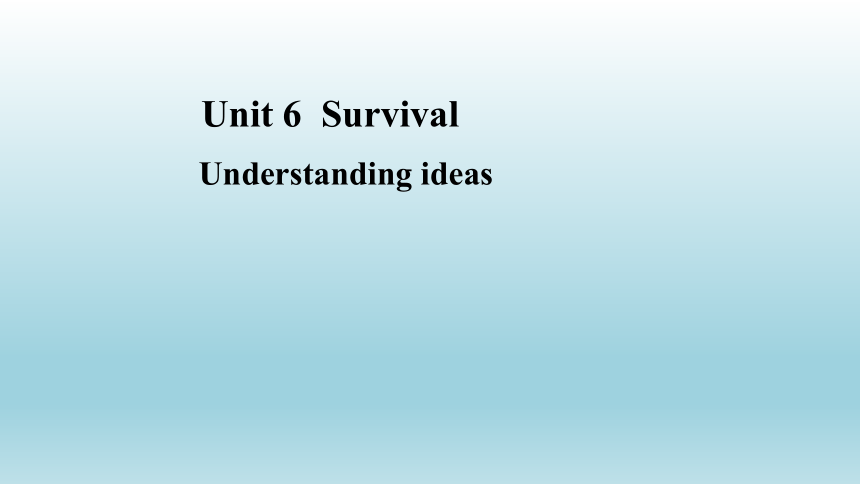 | |
| 格式 | pptx | ||
| 文件大小 | 1.2MB | ||
| 资源类型 | 教案 | ||
| 版本资源 | 外研版(2019) | ||
| 科目 | 英语 | ||
| 更新时间 | 2023-03-04 09:25:36 | ||
图片预览

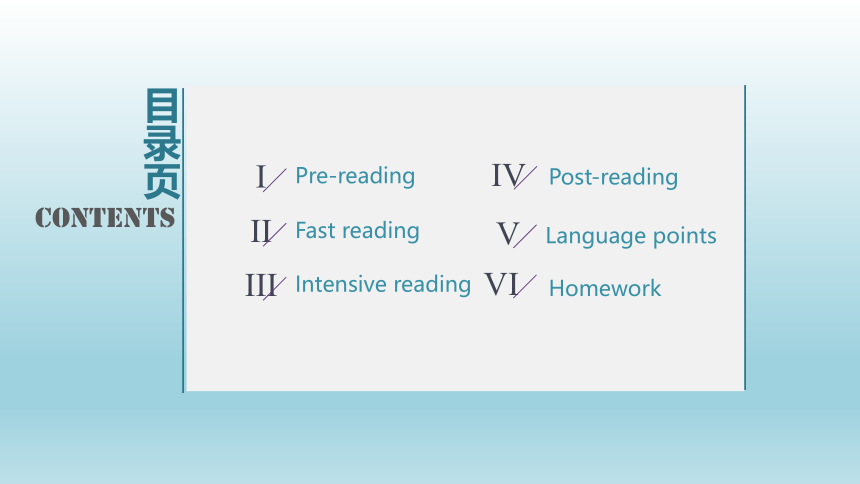
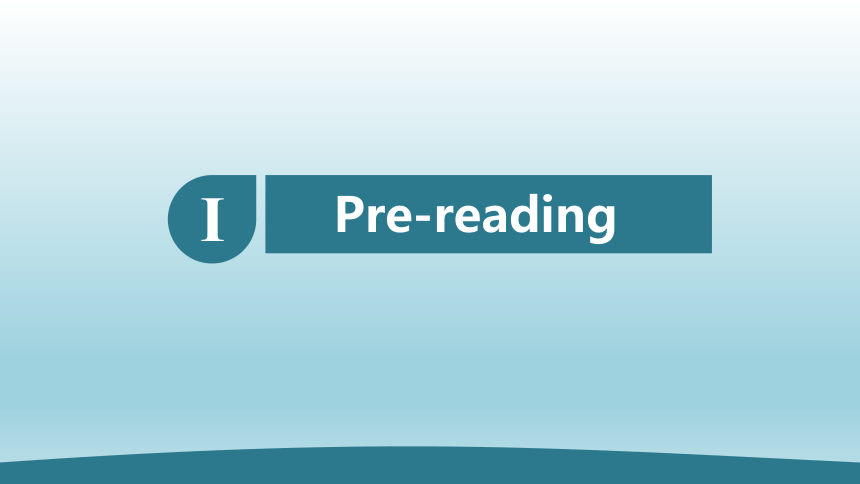

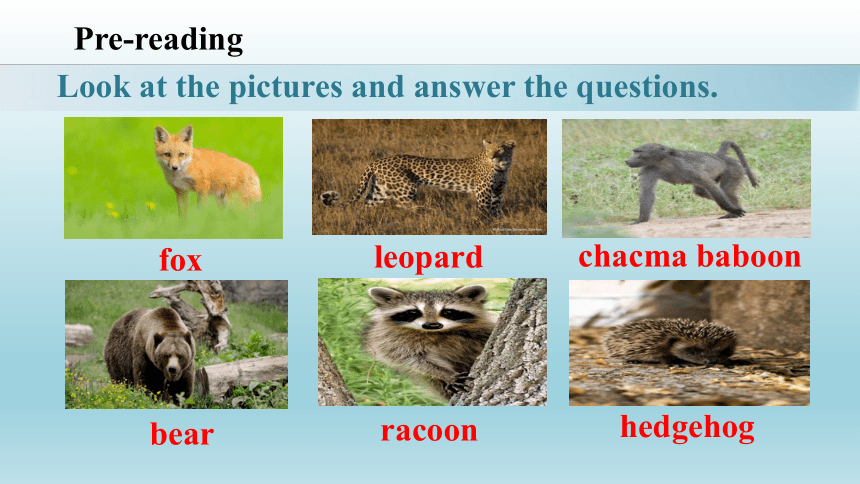
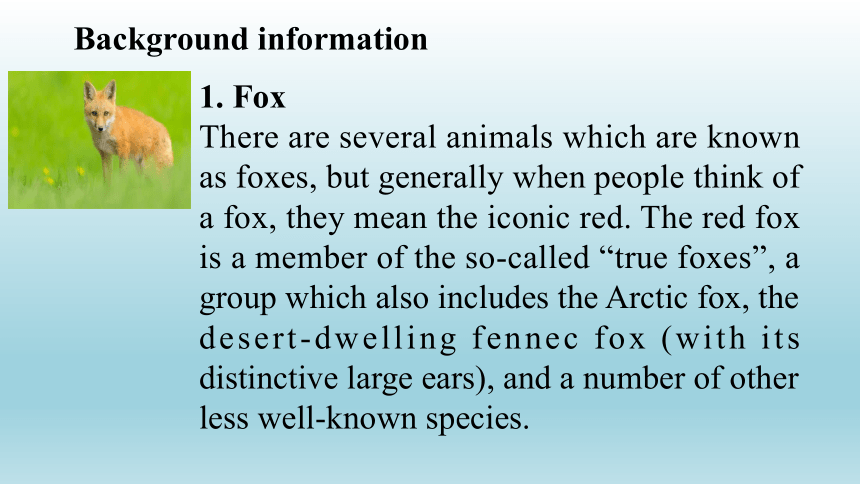
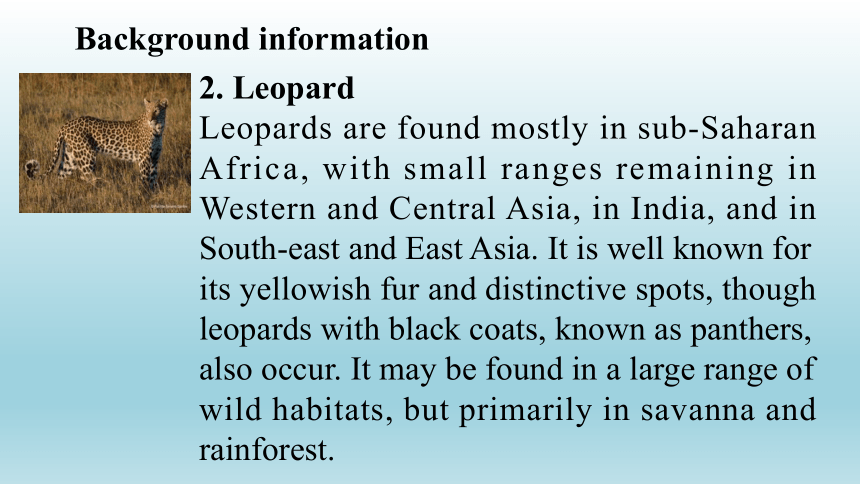
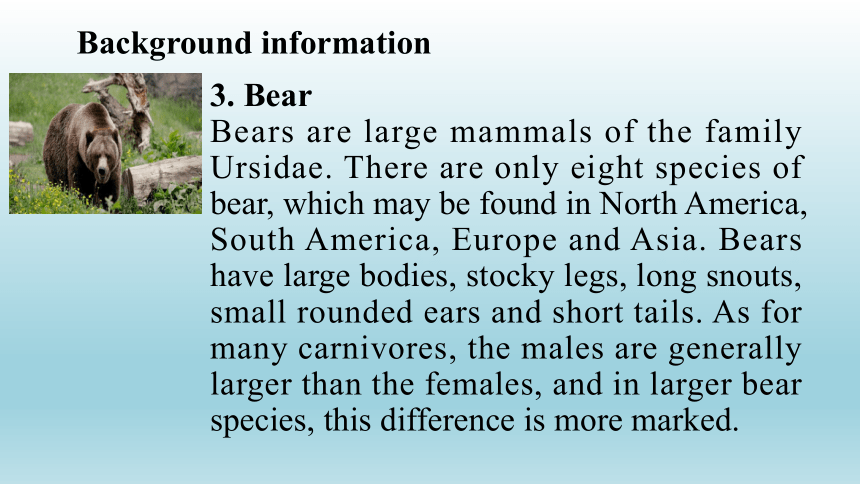
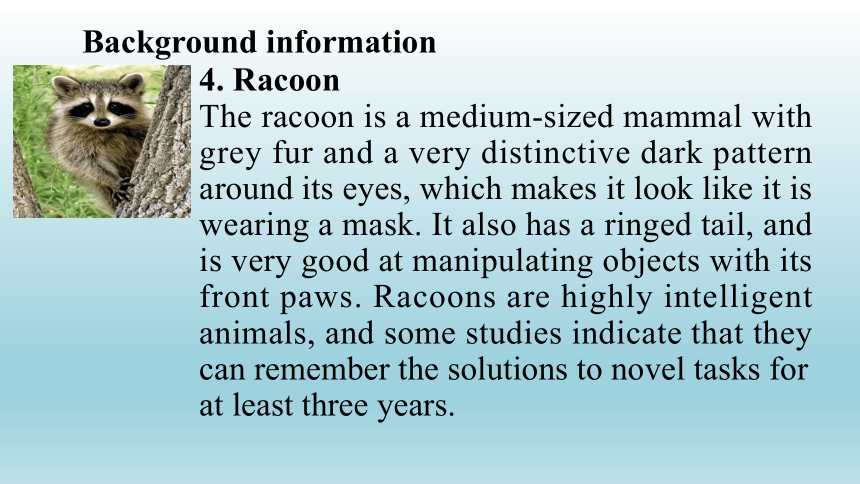
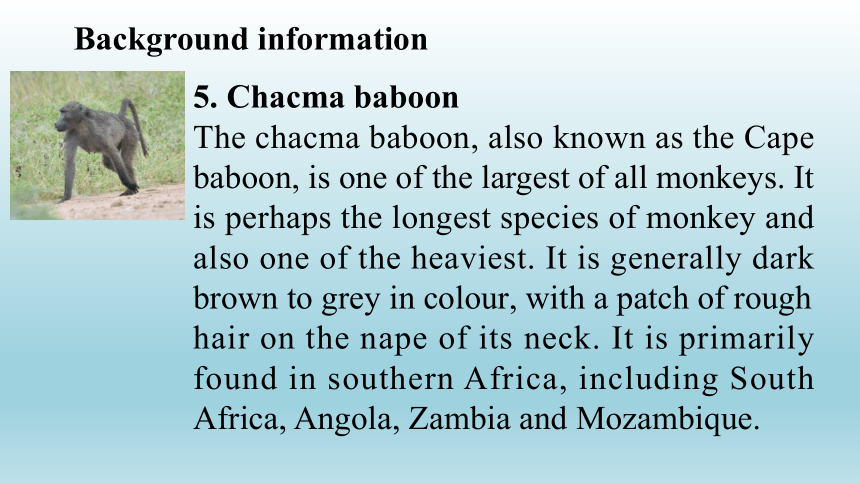
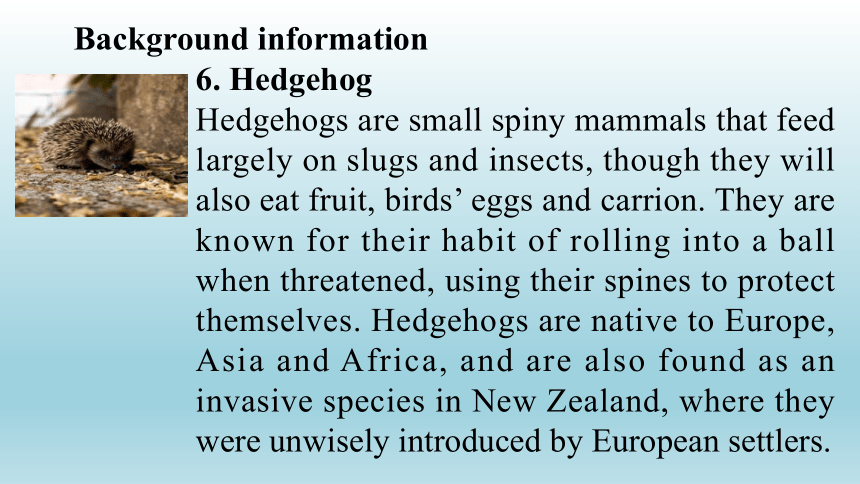
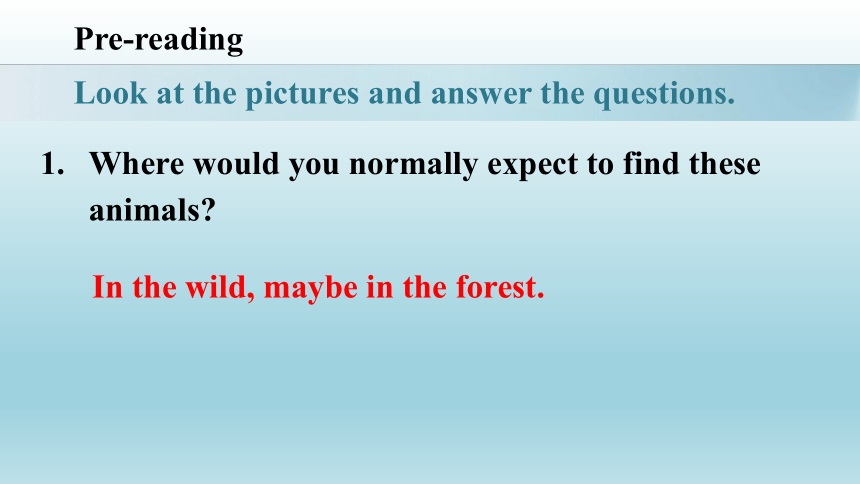
文档简介
(共55张PPT)
Unit 6 Survival
Understanding ideas
目录页
contents
Pre-reading
I
Language points
Ⅳ
Fast reading
II
Homework
Ⅴ
Intensive reading
III
VI
Post-reading
Ⅰ
Pre-reading
Pre-reading
Look at the pictures and answer the questions.
1. Where would you normally expect to find these animals
2. Would you be surprised to see these animals in a city Why or why not
3. What problems could they encounter in cities
Pre-reading
Look at the pictures and answer the questions.
fox
leopard
bear
racoon
chacma baboon
hedgehog
1. Fox
There are several animals which are known as foxes, but generally when people think of a fox, they mean the iconic red. The red fox is a member of the so-called “true foxes”, a group which also includes the Arctic fox, the desert-dwelling fennec fox (with its distinctive large ears), and a number of other less well-known species.
Background information
2. Leopard
Leopards are found mostly in sub-Saharan Africa, with small ranges remaining in Western and Central Asia, in India, and in South-east and East Asia. It is well known for its yellowish fur and distinctive spots, though leopards with black coats, known as panthers, also occur. It may be found in a large range of wild habitats, but primarily in savanna and rainforest.
Background information
3. Bear
Bears are large mammals of the family Ursidae. There are only eight species of bear, which may be found in North America, South America, Europe and Asia. Bears have large bodies, stocky legs, long snouts, small rounded ears and short tails. As for many carnivores, the males are generally larger than the females, and in larger bear species, this difference is more marked.
Background information
4. Racoon
The racoon is a medium-sized mammal with grey fur and a very distinctive dark pattern around its eyes, which makes it look like it is wearing a mask. It also has a ringed tail, and is very good at manipulating objects with its front paws. Racoons are highly intelligent animals, and some studies indicate that they can remember the solutions to novel tasks for at least three years.
Background information
5. Chacma baboon
The chacma baboon, also known as the Cape baboon, is one of the largest of all monkeys. It is perhaps the longest species of monkey and also one of the heaviest. It is generally dark brown to grey in colour, with a patch of rough hair on the nape of its neck. It is primarily found in southern Africa, including South Africa, Angola, Zambia and Mozambique.
Background information
6. Hedgehog
Hedgehogs are small spiny mammals that feed largely on slugs and insects, though they will also eat fruit, birds’ eggs and carrion. They are known for their habit of rolling into a ball when threatened, using their spines to protect themselves. Hedgehogs are native to Europe, Asia and Africa, and are also found as an invasive species in New Zealand, where they were unwisely introduced by European settlers.
Background information
Pre-reading
Look at the pictures and answer the questions.
Where would you normally expect to find these animals
In the wild, maybe in the forest.
Pre-reading
2. Would you be surprised to see these animals in a city Why or why not
Yeah, it is not common to see them in a city.
Not surprised at all, after all, the environment has improved a lot these years.
Look at the pictures and answer the questions.
Pre-reading
3. What problems could they encounter in cities
They may have difficulties finding food, shelter and mates. If people find them, they may be trapped or killed.
Look at the pictures and answer the questions.
Ⅱ
Fast reading
Pre-reading
Look at the title of the passage and the picture. Think about what the title means.
The title means the wild animals within the cities.
Fast reading
Choose the topic sentences for Paragraphs 2–5 and write them on the lines to complete the passage.
a. One thing crucial to the increasing number of “urban animals” is their ability to adapt.
b. People often wonder about the reasons behind this mass urban migration.
Para 4
Para 2
Fast reading
Choose the topic sentences for Paragraphs 2–5 and write them on the lines to complete the passage.
c. For those animals that don’t adapt, the city can be a dangerous or even deadly place.
d. Yet, for its newest and wildest inhabitants, a city can offer many benefits.
Para 5
Para 3
III
Intensive reading
Intensive reading: Find detailed information
Organize information from the passage and complete the diagram.
More and more wild animals are entering cities.
Reasons for migration:
Urban development and climate change push the animals 1. ___________________________________________.
2. ___________________________________________
___________________________________________
___________________________________________
out of their natural habitats
Wherever they go, animals find towns and cities in their way. With nowhere else to make their homes, they have no choice but to move in with us.
Intensive reading: Find detailed information
Organize information from the passage and complete the diagram.
More and more wild animals are entering cities.
Benefits of cities for animals:
Appealing spaces as habitats.
3. _____________________________________________
_____________________________________________
4. _____________________________________________
_____________________________________________
Out of reach from many of their natural predators, these newcomers often flourish in their new city lives.
Hungry animals are finding plenty to eat in our gardens and in the leftovers we throw away.
Intensive reading: Find detailed information
Animals’ adaption to cities:
Urban animals are more 5. ____________________
_______
6. ________________________________________
__________________________________________
Organize information from the passage and complete the diagram.
intelligent than their wild
Some animals have even changed their living
habits to fit in with their new homes.
cousins.
More and more wild animals are entering cities.
Intensive reading: Find detailed information
Dangers for some animals:
7. ____________________________________________________
____________________________________________________
8. ____________________________________________________
____________________________________________________
Organize information from the passage and complete the diagram.
Some birds crash into windows because they are unable to distinguish between blue sky and glass.
Some birds have yet to change their migratory routes that take them through cities with highrise buildings.
More and more wild animals are entering cities.
Intensive reading: Find detailed information
We should learn to better understand and appreciate our wild neighbours, and 9. _________________________
____________________________________________
Organize information from the passage and complete the diagram.
look towards harmoniously sharing our urban habitats.
Ⅳ
Post-reading
Now think about what people can do to achieve a balance between the need for urban development and the protection of wild animals.
Post-reading: Think and share
1. How would you describe the relationship between
people and urban animals in the passage
Post-reading: Think and share
A balanced relationship. People live in the cities and some animals also see them as habitats.
A harmonious relationship. People and animals can get what they need from the cities.
2. What figure of speech is used in the first
paragraph Why does the author choose to
start the passage this way
Post-reading: Think and share
In the first paragraph, the author uses personification to describe what urban animals are doing, with the aim of attracting readers’ attention.
3. Some environmentalists argue that we should
restrict urban development to leave enough
natural habitats for wild animals. Do you agree
with this Give your reasons.
Post-reading: Think and share
I totally agree with this idea, because we can leave some places for animals to use as habitats.
Language points
Ⅴ
I’ve just spotted a mistake on the cover.
我刚才在封面上发现了一处错误。
1. spot v 注意到;发现
Language points: Important words
spot sb doing sth 看到某人在做某事
I spotted someone coming out of the campus.
我看见有人从校园里走出来了。
on the spot 当场;当面;立即;马上
I can’t give you a decision on the spot.
我不能马上给你答复。
2. hesitate v 犹豫;迟疑
I didn’t hesitate for a moment about taking the job.
我毫不犹豫地接受了那份工作。
don’t hesitate to do sth 尽管做某事
If you have any questions, please don’t hesitate to find me. 如果你有任何问题,请尽管告诉我。
Language points: Important words
Language points: Important words
hesitation n 犹豫,迟疑
without hesitation 毫不犹豫地
He accepted my offer without hesitation.
他毫不犹豫地接受了我的提议。
3. flourish v 繁荣; 昌盛; 兴旺
Language points: Important words
These plants flourish in a damp climate.
这些植物在潮湿条件下长势茂盛。
Few businesses are flourishing in the present economic climate.
在目前的经济环境下,很少有企业兴旺发达。
Language points: Important words
4. reward n 奖励;回报;报酬
If you are always lending a helping hand, you will someday get something as a reward.
如果你总是帮助别人,某天你可能会得到一些奖励。
Language points: Important phrases
1. commit a crime ___________________
2. take over ___________________
3. be responsible for ___________________
4. have no choice but to do sth ___________________
5. under construction ___________________
犯罪
接管
为……负责
别无选择只能做某事
在建设中
Language points: Important phrases
6. figure out ______________
7. fit in with ______________
8. get a taste for ______________
9. distinguish between A and B ______________
10. amount to ______________
11. get a better understanding of ______________
弄清楚
适应
品尝
在 A 和 B 之间区分
占……比;总计
更好地理解
2. Once almost unheard of, scenes like this one in Cape Town are now common all over the world.
Paraphrase: Once scenes such as this one in Cape Town were very rare, but now they are common all over the world.
once almost unheard of 是过去分词结构,在句中作时间状语 。
Language points: Important sentences
如何辨别什么时候用现在分词还是过去分词作状语?
关键就是看句子主语是该(非谓语动词)动作的施动者,还是该动作的承受者。
非谓语动词作状语
Entering the room, he found Jerry was seated at the desk.
主语 Jerry 和 enter 是主动关系,故用 entering。
Surrounded by a garden, this house enjoys fresh air almost all the time.
主语 this house 和 surround 是被动关系,故用 surrounded。
Language points: Important sentences
1) ________ (stand) at the top of the mountain, he enjoyed
a grand sight of the city.
2) _____ (see) from the above, this house looks very small.
3) _______ (enjoy) a wonderful sight of the city, he goes
to the top of the mountain.
Standing
Seen
To enjoy
主语 he 是动作 stand 的施动者
主语 this house 是动作 see 的承受者
此处用 to enjoy 表示目的
Language points: Important sentences
3. With foxes in London, mountain lions in San Francisco and wild pigs in Hong Kong, it is almost as if our cities are being taken over by wild animals.
Paraphrase: There are foxes in London, mountain lions in San Francisco and wild pigs in Hong Kong, as if these wild animals are replacing us human beings in our cities.
Language points: Important sentences
with foxes in London, mountain lions in San Francisco and wild pigs in Hong Kong 为 with 的复合结构:with + 宾语 + 宾语补足语,该结构在句子中一般表示原因、伴随、条件等成分。本课中还有以下用到该结构的句子:
Spotting the car with its window left open, the greedy thief didn’t hesitate.
With nowhere else to make their homes, they have no choice but to move in with us.
Language points: Important sentences
with + 宾语(sb / sth) + doing (注:当宾语和宾补动作是主动关系时,可以用 doing 作宾补成分)
With so many people communicating in English, English is becoming more and more important.
有那么多人用英语交流,英语正在变得越来越重要。
此句中,宾语 people 和宾补 communicate 是主动关系,故宾补用 communicating 的形式。
with的复合结构
Language points: Important sentences
2) with + 宾语 + done (注:当宾语和宾补是被动关系时,可以用 done 作宾补成分)
She stood with her arms crossed, staring out the window. 她双臂交叉站着,眼睛盯着窗外。
此句中,宾语 her arms 和宾补 cross 是被动关系,故宾补用过去分词 crossed 的形式。
Language points: Important sentences
3) with + 宾语 +动词不定式 (注:当宾补的动作在将来发生时,可用 to do 作宾补成分)
With a great many clothes to wash, I can’t go out now.
有好多衣服要洗,我现在没法出去。
此句中,衣服是将来要洗,我们可以用动词不定式作宾补,故用 to wash 的形式。
Language points: Important sentences
4) with + 宾语 + 形容词
You shouldn’t speak with your mouth full.
嘴里有东西的时候不应该说话。
5) with + 宾语 + 副词
He stood in front of his mother with his head down.
他低着头站在妈妈面前。
6) with + 宾语 + 介词短语
Lucy ran away with tears in her eyes.
露西眼含泪水跑开了。
Language points: Important sentences
Paraphrase: We can expect to share our urban habitats harmoniously only at that time.
4. Only then can we look towards harmoniously sharing our urban habitats.
此句中,only放在句首修饰状语时,主句采用部分倒装的形式。具体形式是:
only + 状语 + 助动词 + 主语 + 谓语动词 + ……
Language points: Important sentences
1) only + 副词 + 助动词 + 主语 + 谓语动词
Only then will you know the outcome.
只有到那个时候你才知道后果。
2) only + 介词短语 + 助动词 + 主语 + 谓语动词
Only in this way can you realise your dreams.
只有用这种方式,你才能实现你的梦想。
Language points: Important sentences
3) only + 状语从句 + 助动词 + 主语 + 谓语动词
Only when you are focused on the things can you achieve a high level of efficiency.
只有当你专心做事的时候,才能实现高效率。
Language points: Important sentences
翻译:
1) 他只有叫喊才能让别人听到他。
Only by shouting was he able to make himself heard.
2) 只有你的身份通过验证,你才能够进去。
Only when your identity has been checked will you be allowed in.
Language points: Important sentences
5. Although naturally active at night, urban foxes come out in daylight if the reward is good enough.
Although naturally active at night是although 引导的让步状语从句省略形式。
Paraphrase: Although urban foxes are naturally active at night, they also come out in daylight if there is a lot of food.
Language points: Important sentences
Language points: Important sentences
状语从句的省略
如果从句中的主语和主句中的主语一致,且从句动词含有 be 动词,就可以把状语从句中的主语和谓语的一部分或全部省略,从而使语言更加简洁。
1) He is a good man, though sometimes (he is) rather
dull. 他是个好人,尽管有时相当无聊。
2) When (she was) very young, she began to learn to
play the piano. 她很小的时候,就开始学习弹钢琴。
Language points: Important sentences
翻译:
1) 虽然他已年过八十,却比我走得快。
2) 冰经过加热能变成水。
While (he is) over eighty, this man can walk faster than I.
When (it is) heated, ice can turn into water.
VI
Homework
Homework
From the passage, we know we humans are not the only residents of the cities, some animals also are. Therefore, in order to create a better environment for both humans and animals, what steps can you think of for us to take
Unit 6 Survival
Understanding ideas
目录页
contents
Pre-reading
I
Language points
Ⅳ
Fast reading
II
Homework
Ⅴ
Intensive reading
III
VI
Post-reading
Ⅰ
Pre-reading
Pre-reading
Look at the pictures and answer the questions.
1. Where would you normally expect to find these animals
2. Would you be surprised to see these animals in a city Why or why not
3. What problems could they encounter in cities
Pre-reading
Look at the pictures and answer the questions.
fox
leopard
bear
racoon
chacma baboon
hedgehog
1. Fox
There are several animals which are known as foxes, but generally when people think of a fox, they mean the iconic red. The red fox is a member of the so-called “true foxes”, a group which also includes the Arctic fox, the desert-dwelling fennec fox (with its distinctive large ears), and a number of other less well-known species.
Background information
2. Leopard
Leopards are found mostly in sub-Saharan Africa, with small ranges remaining in Western and Central Asia, in India, and in South-east and East Asia. It is well known for its yellowish fur and distinctive spots, though leopards with black coats, known as panthers, also occur. It may be found in a large range of wild habitats, but primarily in savanna and rainforest.
Background information
3. Bear
Bears are large mammals of the family Ursidae. There are only eight species of bear, which may be found in North America, South America, Europe and Asia. Bears have large bodies, stocky legs, long snouts, small rounded ears and short tails. As for many carnivores, the males are generally larger than the females, and in larger bear species, this difference is more marked.
Background information
4. Racoon
The racoon is a medium-sized mammal with grey fur and a very distinctive dark pattern around its eyes, which makes it look like it is wearing a mask. It also has a ringed tail, and is very good at manipulating objects with its front paws. Racoons are highly intelligent animals, and some studies indicate that they can remember the solutions to novel tasks for at least three years.
Background information
5. Chacma baboon
The chacma baboon, also known as the Cape baboon, is one of the largest of all monkeys. It is perhaps the longest species of monkey and also one of the heaviest. It is generally dark brown to grey in colour, with a patch of rough hair on the nape of its neck. It is primarily found in southern Africa, including South Africa, Angola, Zambia and Mozambique.
Background information
6. Hedgehog
Hedgehogs are small spiny mammals that feed largely on slugs and insects, though they will also eat fruit, birds’ eggs and carrion. They are known for their habit of rolling into a ball when threatened, using their spines to protect themselves. Hedgehogs are native to Europe, Asia and Africa, and are also found as an invasive species in New Zealand, where they were unwisely introduced by European settlers.
Background information
Pre-reading
Look at the pictures and answer the questions.
Where would you normally expect to find these animals
In the wild, maybe in the forest.
Pre-reading
2. Would you be surprised to see these animals in a city Why or why not
Yeah, it is not common to see them in a city.
Not surprised at all, after all, the environment has improved a lot these years.
Look at the pictures and answer the questions.
Pre-reading
3. What problems could they encounter in cities
They may have difficulties finding food, shelter and mates. If people find them, they may be trapped or killed.
Look at the pictures and answer the questions.
Ⅱ
Fast reading
Pre-reading
Look at the title of the passage and the picture. Think about what the title means.
The title means the wild animals within the cities.
Fast reading
Choose the topic sentences for Paragraphs 2–5 and write them on the lines to complete the passage.
a. One thing crucial to the increasing number of “urban animals” is their ability to adapt.
b. People often wonder about the reasons behind this mass urban migration.
Para 4
Para 2
Fast reading
Choose the topic sentences for Paragraphs 2–5 and write them on the lines to complete the passage.
c. For those animals that don’t adapt, the city can be a dangerous or even deadly place.
d. Yet, for its newest and wildest inhabitants, a city can offer many benefits.
Para 5
Para 3
III
Intensive reading
Intensive reading: Find detailed information
Organize information from the passage and complete the diagram.
More and more wild animals are entering cities.
Reasons for migration:
Urban development and climate change push the animals 1. ___________________________________________.
2. ___________________________________________
___________________________________________
___________________________________________
out of their natural habitats
Wherever they go, animals find towns and cities in their way. With nowhere else to make their homes, they have no choice but to move in with us.
Intensive reading: Find detailed information
Organize information from the passage and complete the diagram.
More and more wild animals are entering cities.
Benefits of cities for animals:
Appealing spaces as habitats.
3. _____________________________________________
_____________________________________________
4. _____________________________________________
_____________________________________________
Out of reach from many of their natural predators, these newcomers often flourish in their new city lives.
Hungry animals are finding plenty to eat in our gardens and in the leftovers we throw away.
Intensive reading: Find detailed information
Animals’ adaption to cities:
Urban animals are more 5. ____________________
_______
6. ________________________________________
__________________________________________
Organize information from the passage and complete the diagram.
intelligent than their wild
Some animals have even changed their living
habits to fit in with their new homes.
cousins.
More and more wild animals are entering cities.
Intensive reading: Find detailed information
Dangers for some animals:
7. ____________________________________________________
____________________________________________________
8. ____________________________________________________
____________________________________________________
Organize information from the passage and complete the diagram.
Some birds crash into windows because they are unable to distinguish between blue sky and glass.
Some birds have yet to change their migratory routes that take them through cities with highrise buildings.
More and more wild animals are entering cities.
Intensive reading: Find detailed information
We should learn to better understand and appreciate our wild neighbours, and 9. _________________________
____________________________________________
Organize information from the passage and complete the diagram.
look towards harmoniously sharing our urban habitats.
Ⅳ
Post-reading
Now think about what people can do to achieve a balance between the need for urban development and the protection of wild animals.
Post-reading: Think and share
1. How would you describe the relationship between
people and urban animals in the passage
Post-reading: Think and share
A balanced relationship. People live in the cities and some animals also see them as habitats.
A harmonious relationship. People and animals can get what they need from the cities.
2. What figure of speech is used in the first
paragraph Why does the author choose to
start the passage this way
Post-reading: Think and share
In the first paragraph, the author uses personification to describe what urban animals are doing, with the aim of attracting readers’ attention.
3. Some environmentalists argue that we should
restrict urban development to leave enough
natural habitats for wild animals. Do you agree
with this Give your reasons.
Post-reading: Think and share
I totally agree with this idea, because we can leave some places for animals to use as habitats.
Language points
Ⅴ
I’ve just spotted a mistake on the cover.
我刚才在封面上发现了一处错误。
1. spot v 注意到;发现
Language points: Important words
spot sb doing sth 看到某人在做某事
I spotted someone coming out of the campus.
我看见有人从校园里走出来了。
on the spot 当场;当面;立即;马上
I can’t give you a decision on the spot.
我不能马上给你答复。
2. hesitate v 犹豫;迟疑
I didn’t hesitate for a moment about taking the job.
我毫不犹豫地接受了那份工作。
don’t hesitate to do sth 尽管做某事
If you have any questions, please don’t hesitate to find me. 如果你有任何问题,请尽管告诉我。
Language points: Important words
Language points: Important words
hesitation n 犹豫,迟疑
without hesitation 毫不犹豫地
He accepted my offer without hesitation.
他毫不犹豫地接受了我的提议。
3. flourish v 繁荣; 昌盛; 兴旺
Language points: Important words
These plants flourish in a damp climate.
这些植物在潮湿条件下长势茂盛。
Few businesses are flourishing in the present economic climate.
在目前的经济环境下,很少有企业兴旺发达。
Language points: Important words
4. reward n 奖励;回报;报酬
If you are always lending a helping hand, you will someday get something as a reward.
如果你总是帮助别人,某天你可能会得到一些奖励。
Language points: Important phrases
1. commit a crime ___________________
2. take over ___________________
3. be responsible for ___________________
4. have no choice but to do sth ___________________
5. under construction ___________________
犯罪
接管
为……负责
别无选择只能做某事
在建设中
Language points: Important phrases
6. figure out ______________
7. fit in with ______________
8. get a taste for ______________
9. distinguish between A and B ______________
10. amount to ______________
11. get a better understanding of ______________
弄清楚
适应
品尝
在 A 和 B 之间区分
占……比;总计
更好地理解
2. Once almost unheard of, scenes like this one in Cape Town are now common all over the world.
Paraphrase: Once scenes such as this one in Cape Town were very rare, but now they are common all over the world.
once almost unheard of 是过去分词结构,在句中作时间状语 。
Language points: Important sentences
如何辨别什么时候用现在分词还是过去分词作状语?
关键就是看句子主语是该(非谓语动词)动作的施动者,还是该动作的承受者。
非谓语动词作状语
Entering the room, he found Jerry was seated at the desk.
主语 Jerry 和 enter 是主动关系,故用 entering。
Surrounded by a garden, this house enjoys fresh air almost all the time.
主语 this house 和 surround 是被动关系,故用 surrounded。
Language points: Important sentences
1) ________ (stand) at the top of the mountain, he enjoyed
a grand sight of the city.
2) _____ (see) from the above, this house looks very small.
3) _______ (enjoy) a wonderful sight of the city, he goes
to the top of the mountain.
Standing
Seen
To enjoy
主语 he 是动作 stand 的施动者
主语 this house 是动作 see 的承受者
此处用 to enjoy 表示目的
Language points: Important sentences
3. With foxes in London, mountain lions in San Francisco and wild pigs in Hong Kong, it is almost as if our cities are being taken over by wild animals.
Paraphrase: There are foxes in London, mountain lions in San Francisco and wild pigs in Hong Kong, as if these wild animals are replacing us human beings in our cities.
Language points: Important sentences
with foxes in London, mountain lions in San Francisco and wild pigs in Hong Kong 为 with 的复合结构:with + 宾语 + 宾语补足语,该结构在句子中一般表示原因、伴随、条件等成分。本课中还有以下用到该结构的句子:
Spotting the car with its window left open, the greedy thief didn’t hesitate.
With nowhere else to make their homes, they have no choice but to move in with us.
Language points: Important sentences
with + 宾语(sb / sth) + doing (注:当宾语和宾补动作是主动关系时,可以用 doing 作宾补成分)
With so many people communicating in English, English is becoming more and more important.
有那么多人用英语交流,英语正在变得越来越重要。
此句中,宾语 people 和宾补 communicate 是主动关系,故宾补用 communicating 的形式。
with的复合结构
Language points: Important sentences
2) with + 宾语 + done (注:当宾语和宾补是被动关系时,可以用 done 作宾补成分)
She stood with her arms crossed, staring out the window. 她双臂交叉站着,眼睛盯着窗外。
此句中,宾语 her arms 和宾补 cross 是被动关系,故宾补用过去分词 crossed 的形式。
Language points: Important sentences
3) with + 宾语 +动词不定式 (注:当宾补的动作在将来发生时,可用 to do 作宾补成分)
With a great many clothes to wash, I can’t go out now.
有好多衣服要洗,我现在没法出去。
此句中,衣服是将来要洗,我们可以用动词不定式作宾补,故用 to wash 的形式。
Language points: Important sentences
4) with + 宾语 + 形容词
You shouldn’t speak with your mouth full.
嘴里有东西的时候不应该说话。
5) with + 宾语 + 副词
He stood in front of his mother with his head down.
他低着头站在妈妈面前。
6) with + 宾语 + 介词短语
Lucy ran away with tears in her eyes.
露西眼含泪水跑开了。
Language points: Important sentences
Paraphrase: We can expect to share our urban habitats harmoniously only at that time.
4. Only then can we look towards harmoniously sharing our urban habitats.
此句中,only放在句首修饰状语时,主句采用部分倒装的形式。具体形式是:
only + 状语 + 助动词 + 主语 + 谓语动词 + ……
Language points: Important sentences
1) only + 副词 + 助动词 + 主语 + 谓语动词
Only then will you know the outcome.
只有到那个时候你才知道后果。
2) only + 介词短语 + 助动词 + 主语 + 谓语动词
Only in this way can you realise your dreams.
只有用这种方式,你才能实现你的梦想。
Language points: Important sentences
3) only + 状语从句 + 助动词 + 主语 + 谓语动词
Only when you are focused on the things can you achieve a high level of efficiency.
只有当你专心做事的时候,才能实现高效率。
Language points: Important sentences
翻译:
1) 他只有叫喊才能让别人听到他。
Only by shouting was he able to make himself heard.
2) 只有你的身份通过验证,你才能够进去。
Only when your identity has been checked will you be allowed in.
Language points: Important sentences
5. Although naturally active at night, urban foxes come out in daylight if the reward is good enough.
Although naturally active at night是although 引导的让步状语从句省略形式。
Paraphrase: Although urban foxes are naturally active at night, they also come out in daylight if there is a lot of food.
Language points: Important sentences
Language points: Important sentences
状语从句的省略
如果从句中的主语和主句中的主语一致,且从句动词含有 be 动词,就可以把状语从句中的主语和谓语的一部分或全部省略,从而使语言更加简洁。
1) He is a good man, though sometimes (he is) rather
dull. 他是个好人,尽管有时相当无聊。
2) When (she was) very young, she began to learn to
play the piano. 她很小的时候,就开始学习弹钢琴。
Language points: Important sentences
翻译:
1) 虽然他已年过八十,却比我走得快。
2) 冰经过加热能变成水。
While (he is) over eighty, this man can walk faster than I.
When (it is) heated, ice can turn into water.
VI
Homework
Homework
From the passage, we know we humans are not the only residents of the cities, some animals also are. Therefore, in order to create a better environment for both humans and animals, what steps can you think of for us to take
